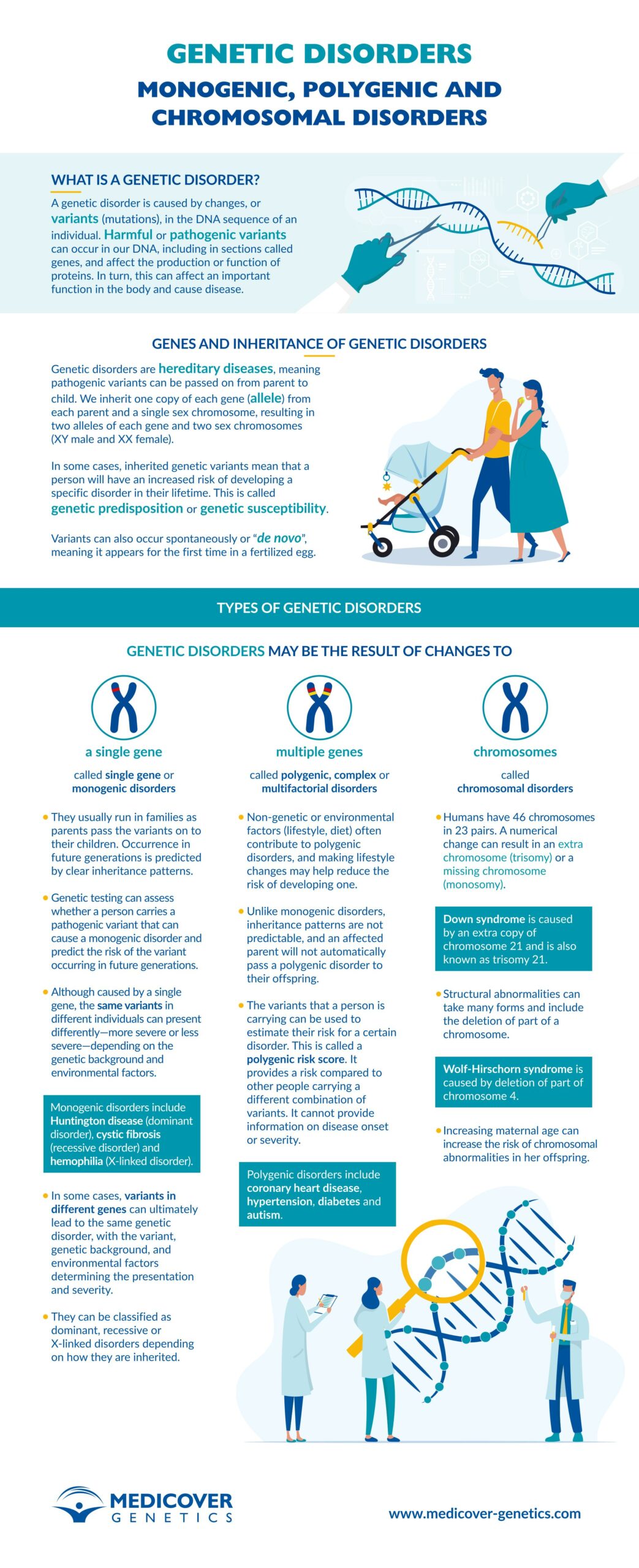Genetic disorders are diseases caused by changes to an individual’s DNA sequence. Our DNA sequence provides the instructions for making the proteins essential to the human body and a change can mean that a protein is not formed or does not function correctly, leading to a genetic disorder.
Genetic disorders are grouped according to whether the sequence changes occur in one gene, multiple genes or in chromosomes. With this knowledge, it is possible to predict whether a disease will be passed on to offspring, estimate the risk of developing a disease or, in the case of chromosomal disorders, screen for disease before birth.
In this infographic, we introduce the different types of genetic disorders and highlight some key facts about each group, including examples of genetic disorders.
Topics covered in this infographic
- What is a genetic disorder?
- Genes and inheritance of genetic disorders
- Types of genetic disorders:
- – monogenic disorders
- – polygenic gene disorders
- – chromosomal disorders
 Download
DownloadReferences
This infographic was compiled used information from the following sources:
Genetic Alliance; District of Columbia Department of Health. “Understanding Genetics: A District of Columbia Guide for Patients and Health Professionals.” Washington (DC): Genetic Alliance; 2010 Feb 17. Appendix G, Single-Gene Disorders. Available from: https://www.ncbi.nlm.nih.gov/books/NBK132154/. Accessed 13 April 2022.
“What are single gene disorders?” yourgenome.org, https://www.yourgenome.org/facts/what-are-single-gene-disorders. Accessed 13 April 2022.
Genetic Science Learning Center. “Single gene disorders.” Learn.Genetics, 15 Feb 2014, https://learn.genetics.utah.edu/content/disorders/singlegene. Accessed 13 April 2022.
National Human Genome Research Institute. “Polygenic risk scores.” Genome.gov, 11 Aug. 2020, https://www.genome.gov/Health/Genomics-and-Medicine/Polygenic-risk-scores. Accessed 13 April 2022.
Fletcher-Dallas, Robert. “Genetic disorders.” Genetic Alliance UK, 10 May 2016, https://geneticalliance.org.uk/information/learn-about-genetics/genetic-disorders/. Accessed 4 May 2022.
MedlinePlus [Internet]. Bethesda (MD): National Library of Medicine (US); [updated 2020 Jun 24]. “What does it mean to have a genetic predisposition to a disease?” Updated 14 May 2021 Available from: https://medlineplus.gov/genetics/understanding/mutationsanddisorders/predisposition/. Accessed 5 May 2022.
The Editors of the Encyclopedia Britannica. “Chromosomal disorder.” Britannica.com, https://www.britannica.com/science/chromosomal-disorder. Accessed 5 May 2022.
“What is a chromosome disorder?” yourgenome.org, https://www.yourgenome.org/facts/what-is-a-chromosome-disorder. Accessed 5 May 2022.














